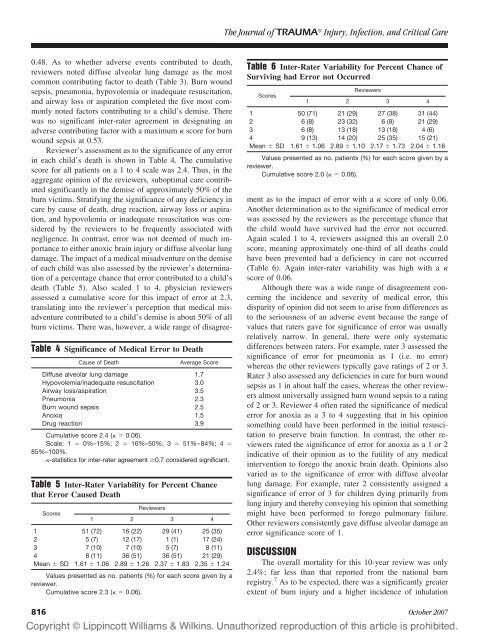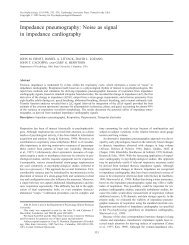Assessment of Adverse Events in the Demise of Pediatric Burn ...
Assessment of Adverse Events in the Demise of Pediatric Burn ...
Assessment of Adverse Events in the Demise of Pediatric Burn ...
You also want an ePaper? Increase the reach of your titles
YUMPU automatically turns print PDFs into web optimized ePapers that Google loves.
The Journal <strong>of</strong> TRAUMA Injury, Infection, and Critical Care<br />
Table 4 Significance <strong>of</strong> Medical Error to Death<br />
Cause <strong>of</strong> Death<br />
Average Score<br />
Diffuse alveolar lung damage 1.7<br />
Hypovolemia/<strong>in</strong>adequate resuscitation 3.0<br />
Airway loss/aspiration 3.5<br />
Pneumonia 2.3<br />
<strong>Burn</strong> wound sepsis 2.5<br />
Anoxia 1.5<br />
Drug reaction 3.9<br />
Cumulative score 2.4 ( 0.06).<br />
Scale: 1 0%–15%; 2 16%–50%; 3 51%–84%; 4 <br />
85%–100%.<br />
-statistics for <strong>in</strong>ter-rater agreement 0.7 considered significant.<br />
Table 5 Inter-Rater Variability for Percent Chance<br />
that Error Caused Death<br />
Reviewers<br />
Scores<br />
1 2 3 4<br />
1 51 (72) 16 (22) 29 (41) 25 (35)<br />
2 5 (7) 12 (17) 1 (1) 17 (24)<br />
3 7 (10) 7 (10) 5 (7) 8 (11)<br />
4 8 (11) 36 (51) 36 (51) 21 (29)<br />
Mean SD 1.61 1.06 2.89 1.26 2.37 1.83 2.35 1.24<br />
Values presented as no. patients (%) for each score given by a<br />
reviewer.<br />
Cumulative score 2.3 ( 0.06).<br />
Table 6 Inter-Rater Variability for Percent Chance <strong>of</strong><br />
Surviv<strong>in</strong>g had Error not Occurred<br />
Reviewers<br />
Scores<br />
1 2 3 4<br />
1 50 (71) 21 (29) 27 (38) 31 (44)<br />
2 6 (8) 23 (32) 6 (8) 21 (29)<br />
3 6 (8) 13 (18) 13 (18) 4 (6)<br />
4 9 (13) 14 (20) 25 (35) 15 (21)<br />
Mean SD 1.61 1.06 2.89 1.10 2.17 1.73 2.04 1.16<br />
Values presented as no. patients (%) for each score given by a<br />
reviewer.<br />
Cumulative score 2.0 ( 0.06).<br />
0.48. As to whe<strong>the</strong>r adverse events contributed to death,<br />
reviewers noted diffuse alveolar lung damage as <strong>the</strong> most<br />
common contribut<strong>in</strong>g factor to death (Table 3). <strong>Burn</strong> wound<br />
sepsis, pneumonia, hypovolemia or <strong>in</strong>adequate resuscitation,<br />
and airway loss or aspiration completed <strong>the</strong> five most commonly<br />
noted factors contribut<strong>in</strong>g to a child’s demise. There<br />
was no significant <strong>in</strong>ter-rater agreement <strong>in</strong> designat<strong>in</strong>g an<br />
adverse contribut<strong>in</strong>g factor with a maximum score for burn<br />
wound sepsis at 0.53.<br />
Reviewer’s assessment as to <strong>the</strong> significance <strong>of</strong> any error<br />
<strong>in</strong> each child’s death is shown <strong>in</strong> Table 4. The cumulative<br />
score for all patients on a1to4scale was 2.4. Thus, <strong>in</strong> <strong>the</strong><br />
aggregate op<strong>in</strong>ion <strong>of</strong> <strong>the</strong> reviewers, suboptimal care contributed<br />
significantly <strong>in</strong> <strong>the</strong> demise <strong>of</strong> approximately 50% <strong>of</strong> <strong>the</strong><br />
burn victims. Stratify<strong>in</strong>g <strong>the</strong> significance <strong>of</strong> any deficiency <strong>in</strong><br />
care by cause <strong>of</strong> death, drug reaction, airway loss or aspiration,<br />
and hypovolemia or <strong>in</strong>adequate resuscitation was considered<br />
by <strong>the</strong> reviewers to be frequently associated with<br />
negligence. In contrast, error was not deemed <strong>of</strong> much importance<br />
to ei<strong>the</strong>r anoxic bra<strong>in</strong> <strong>in</strong>jury or diffuse alveolar lung<br />
damage. The impact <strong>of</strong> a medical misadventure on <strong>the</strong> demise<br />
<strong>of</strong> each child was also assessed by <strong>the</strong> reviewer’s determ<strong>in</strong>ation<br />
<strong>of</strong> a percentage chance that error contributed to a child’s<br />
death (Table 5). Also scaled 1 to 4, physician reviewers<br />
assessed a cumulative score for this impact <strong>of</strong> error at 2.3,<br />
translat<strong>in</strong>g <strong>in</strong>to <strong>the</strong> reviewer’s perception that medical misadventure<br />
contributed to a child’s demise is about 50% <strong>of</strong> all<br />
burn victims. There was, however, a wide range <strong>of</strong> disagreement<br />
as to <strong>the</strong> impact <strong>of</strong> error with a score <strong>of</strong> only 0.06.<br />
Ano<strong>the</strong>r determ<strong>in</strong>ation as to <strong>the</strong> significance <strong>of</strong> medical error<br />
was assessed by <strong>the</strong> reviewers as <strong>the</strong> percentage chance that<br />
<strong>the</strong> child would have survived had <strong>the</strong> error not occurred.<br />
Aga<strong>in</strong> scaled 1 to 4, reviewers assigned this an overall 2.0<br />
score, mean<strong>in</strong>g approximately one-third <strong>of</strong> all deaths could<br />
have been prevented had a deficiency <strong>in</strong> care not occurred<br />
(Table 6). Aga<strong>in</strong> <strong>in</strong>ter-rater variability was high with a <br />
score <strong>of</strong> 0.06.<br />
Although <strong>the</strong>re was a wide range <strong>of</strong> disagreement concern<strong>in</strong>g<br />
<strong>the</strong> <strong>in</strong>cidence and severity <strong>of</strong> medical error, this<br />
disparity <strong>of</strong> op<strong>in</strong>ion did not seem to arise from differences as<br />
to <strong>the</strong> seriousness <strong>of</strong> an adverse event because <strong>the</strong> range <strong>of</strong><br />
values that raters gave for significance <strong>of</strong> error was usually<br />
relatively narrow. In general, <strong>the</strong>re were only systematic<br />
differences between raters. For example, rater 3 assessed <strong>the</strong><br />
significance <strong>of</strong> error for pneumonia as 1 (i.e. no error)<br />
whereas <strong>the</strong> o<strong>the</strong>r reviewers typically gave rat<strong>in</strong>gs <strong>of</strong> 2 or 3.<br />
Rater 3 also assessed any deficiencies <strong>in</strong> care for burn wound<br />
sepsis as 1 <strong>in</strong> about half <strong>the</strong> cases, whereas <strong>the</strong> o<strong>the</strong>r reviewers<br />
almost universally assigned burn wound sepsis to a rat<strong>in</strong>g<br />
<strong>of</strong> 2 or 3. Reviewer 4 <strong>of</strong>ten rated <strong>the</strong> significance <strong>of</strong> medical<br />
error for anoxia as a3to4suggest<strong>in</strong>g that <strong>in</strong> his op<strong>in</strong>ion<br />
someth<strong>in</strong>g could have been performed <strong>in</strong> <strong>the</strong> <strong>in</strong>itial resuscitation<br />
to preserve bra<strong>in</strong> function. In contrast, <strong>the</strong> o<strong>the</strong>r reviewers<br />
rated <strong>the</strong> significance <strong>of</strong> error for anoxia as a1or2<br />
<strong>in</strong>dicative <strong>of</strong> <strong>the</strong>ir op<strong>in</strong>ion as to <strong>the</strong> futility <strong>of</strong> any medical<br />
<strong>in</strong>tervention to forego <strong>the</strong> anoxic bra<strong>in</strong> death. Op<strong>in</strong>ions also<br />
varied as to <strong>the</strong> significance <strong>of</strong> error with diffuse alveolar<br />
lung damage. For example, rater 2 consistently assigned a<br />
significance <strong>of</strong> error <strong>of</strong> 3 for children dy<strong>in</strong>g primarily from<br />
lung <strong>in</strong>jury and <strong>the</strong>reby convey<strong>in</strong>g his op<strong>in</strong>ion that someth<strong>in</strong>g<br />
might have been performed to forego pulmonary failure.<br />
O<strong>the</strong>r reviewers consistently gave diffuse alveolar damage an<br />
error significance score <strong>of</strong> 1.<br />
DISCUSSION<br />
The overall mortality for this 10-year review was only<br />
2.4%; far less than that reported from <strong>the</strong> national burn<br />
registry. 7 As to be expected, <strong>the</strong>re was a significantly greater<br />
extent <strong>of</strong> burn <strong>in</strong>jury and a higher <strong>in</strong>cidence <strong>of</strong> <strong>in</strong>halation<br />
816 October 2007



